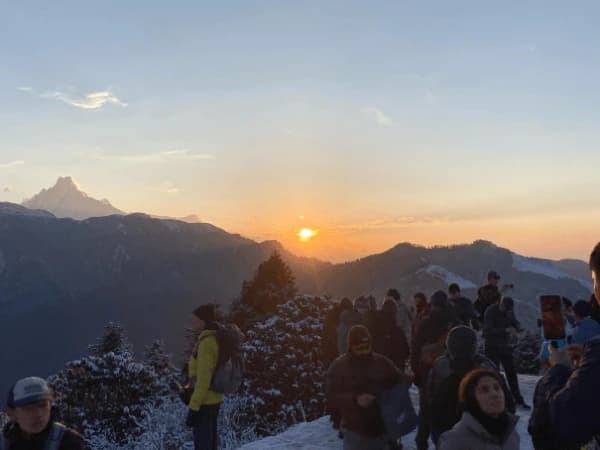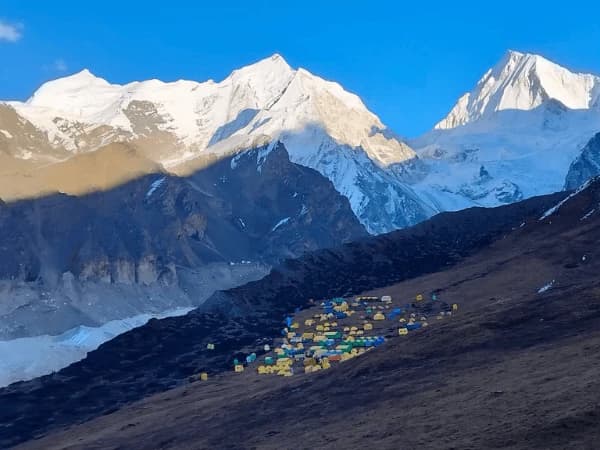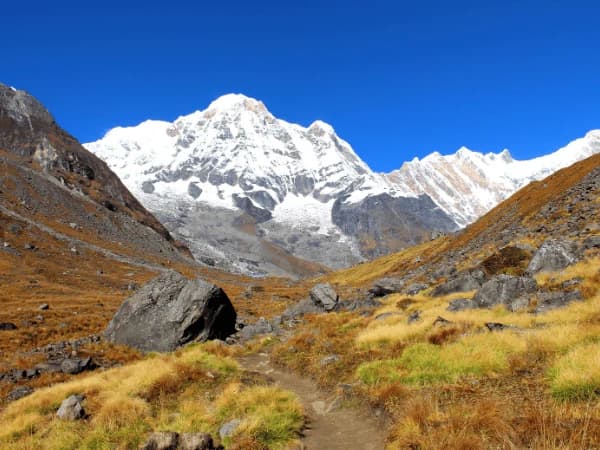Is Annapurna Base Camp Easier Than Everest Base Camp for First-Time Trekkers?
When comparing Annapurna Base Camp vs Everest Base Camp, the Annapurna Base Camp trek (4,130 m) is generally easier and more suitable for first-time trekkers than the Everest Base Camp trek (5,364 m). The difference lies mainly in altitude, terrain, and accessibility, all of which influence how demanding the journey feels.
At higher altitudes, like in the Everest region, oxygen levels drop sharply, increasing the risk of altitude sickness and requiring multiple acclimatisation days in places such as Namche Bazaar or Dingboche. In contrast, the Annapurna region offers a gradual climb through terraced farmlands, lush forests, and Gurung villages, with fewer steep ascents and less risk of AMS.
Accessibility also makes ABC more beginner-friendly — you can reach the trailhead easily from Pokhara by road, while EBC requires a flight to Lukla, often delayed by weather.
For first-timers, Annapurna Base Camp provides a more comfortable trekking experience with lower altitude stress, mild temperatures, and varied landscapes. Meanwhile, Everest Base Camp offers a tougher but iconic adventure for those seeking the thrill of standing near the world’s tallest mountain.
How Many Days are for the Annapurna Base Camp vs the Everest Base Camp Trek Itinerary?
The duration of a trek often determines whether it fits within your travel schedule. Annapurna Base Camp can be done in a shorter time frame, while Everest Base Camp usually demands more days due to higher elevation and acclimatisation needs.
Typical Duration Comparison
|
Trekking Routes
|
Standard Duration
|
Notes
|
|
Annapurna Base Camp
|
7–12 days
|
Accessible by road from Pokhara; no domestic flight delays.
|
|
Everest Base Camp
|
12–14 days
|
Includes acclimatisation days and Lukla flight at the start and end.
|
What Is the Altitude Gain Difference Between Everest Base Camp and Annapurna Base Camp?
Altitude significantly influences your trekking experience. The Everest Base Camp trek is considerably higher than the Annapurna Base Camp trek, which affects oxygen levels, acclimatisation time, and temperature.
Altitude Comparison
- Annapurna Base Camp: 4,130 m (13,550 ft)
- Everest Base Camp: 5,364 m (17,598 ft)
- Kala Patthar viewpoint (EBC): 5,545 m (18,192 ft)
That’s over 1,200 m (4,000 ft) of extra vertical gain for EBC.
Effects of Higher Altitude
- Lower oxygen levels (50% at EBC’s altitude) make breathing and walking more strenuous.
- Greater risk of altitude sickness — especially beyond 4,500 m.
- Colder temperatures, often sub-zero nights, even in autumn.
- More acclimatisation days are needed to prevent AMS.
Tip for Trekkers:
If you’ve never trekked above 4,000 m before, start with Annapurna Base Camp to experience moderate altitude safely. For seasoned hikers seeking a challenge, Everest Base Camp delivers an unmatched high-mountain adventure.
Which Trek Has Better Scenery: ABC or EBC?
Both treks are stunning — but the beauty lies in different forms. Annapurna Base Camp offers diversity and green landscapes, while Everest Base Camp provides raw, high-altitude grandeur.
Annapurna Base Camp Scenery
- Lush forests filled with rhododendrons, oak, and bamboo.
- Traditional Gurung and Magar villages with terraced fields.
- Waterfalls, rivers, and the amphitheater of Annapurna peaks at the base camp.
- The majestic Machapuchare (“Fishtail”) peak dominates the skyline.
Everest Base Camp Scenery
- Towering alpine landscapes with glaciers and barren rock valleys.
- Breathtaking views of Mount Everest, Lhotse, Nuptse, and Ama Dablam.
- The Khumbu Icefall and high-altitude settlements like Tengboche and Lobuche.
Summary:
- Choose ABC for variety — forests, culture, and mountains.
- Choose EBC for scale — dramatic ice walls and world-famous peaks.
Cost Breakdown: Annapurna Base Camp vs Everest Base Camp Trek in Nepal
Budget is often the deciding factor for many trekkers. Although both treks offer options ranging from budget to luxury, the Everest Base Camp trek generally costs more due to higher altitude and logistical challenges.
Average Cost Overview
|
Expense Category
|
Annapurna Base Camp Trek cost
|
Everest Base Camp Trek Cost
|
|
Permits & Fees
|
ACAP + TIMS
|
Sagarmatha National Park + Khumbu Permit
|
|
Transportation
|
Drive/flight to Pokhara
|
Flight to Lukla (costly & weather-dependent)
|
|
Accommodation
|
$20–30 per day
|
$30–60 per day
|
|
Meals & Drinks
|
$25–35 per day
|
$40–60 per day
|
|
Guide/Porter
|
$25–35 per day
|
$30–40 per day
|
|
Total Estimated Cost
|
$800–1,000
|
$1,200–1,600
|
Key Insights
- Prices rise with altitude due to transportation difficulty.
- Lukla flights cost around $225-230one one way, adding significantly to EBC expenses.
- ABC’s easy access from Pokhara keeps the overall cost lower.
- Both regions accept Nepali rupees (cash only beyond cities).
Can I Do the Annapurna Base Camp Trek Instead of the Everest Base Camp if I Have Less Time?
Absolutely! The Annapurna Base Camp trek is one of Nepal’s best short treks, ideal for travelers with limited time who still want a complete Himalayan adventure. Compared to the Everest Base Camp trek, which typically takes 12–14 days, the ABC trek can be comfortably completed in just 7–10 days without compromising on scenery, culture, or mountain experience.
One of the main advantages of Annapurna Base Camp is its easy accessibility. The trek begins with a short drive from Pokhara, eliminating the need for a costly and weather-dependent flight to Lukla, as required for EBC. The lower altitude of ABC (4,130 m) also reduces the need for acclimatization days, making it more practical for those on a tighter schedule. Moreover, the weather in the Annapurna region tends to be more stable, meaning fewer delays and smoother logistics.
This trek is perfect for:
- Trekkers with limited vacation days
- Beginners looking for a moderate yet scenic route
- Travellers who wish to combine trekking with Pokhara or Chitwan tours
If you have under two weeks, the Annapurna Base Camp trek offers the perfect balance of adventure, comfort, and accessibility, allowing you to experience Nepal’s Himalayan beauty without the intensity of Everest’s high-altitude challenges.
Best Season to Trek ABC Compared to EBC
Choosing the best season to trek to Annapurna Base Camp vs Everest Base Camp is essential for a comfortable and rewarding Himalayan adventure. Both treks share similar seasonal patterns, yet their differences in altitude and geography create slightly distinct weather experiences.
The best seasons for both ABC and EBC are Autumn (September–November) and Spring (March–May). During Autumn, trekkers enjoy crystal-clear skies, stable weather, and the best panoramic mountain views. This is the peak trekking season in Nepal, with ideal temperatures and minimal rainfall. Similarly, Spring offers mild weather, longer daylight hours, and blooming rhododendrons across the Annapurna region—making it especially scenic for photographers and nature lovers.
However, seasonal contrasts become more evident during the shoulder and off-seasons. In Winter (December–February), trekking to Annapurna Base Camp remains possible, though expect cold nights and occasional icy trails. On the other hand, Everest Base Camp often becomes inaccessible due to heavy snowfall and freezing temperatures. During the Monsoon (June–August), ABC is lush and vibrant but wet, while EBC faces frequent flight cancellations to Lukla, disrupting itineraries.
For ideal trekking conditions, Autumn is the most reliable season for both regions. If you prefer fewer crowds and colourful landscapes, late March to early May in the Annapurna region is a perfect choice for a rewarding and tranquil Himalayan journey.
Which Is the Best Trek Between the Everest Base Camp and Annapurna Base Camp Trek?
Both treks are exceptional, but the “best” depends on your goals, experience, and fitness. Below is a quick comparative analysis.
Comparison Table
|
Criteria
|
Everest Base Camp
|
Annapurna Base Camp
|
|
Altitude & Difficulty
|
Higher (5,364 m), challenging
|
Lower (4,130 m), moderate
|
|
Scenery
|
Pure alpine landscapes, glaciers
|
Diverse — forests, rivers, and snow peaks
|
|
Cultural Experience
|
Sherpa villages, monasteries
|
Gurung, Magar, and mixed ethnic villages
|
|
Accessibility
|
Requires Lukla flight
|
Road-accessible from Pokhara
|
|
Cost
|
Higher
|
More budget-friendly
|
|
Ideal For
|
Experienced trekkers
|
Beginners & short-term travelers
|
How to Choose
- Choose Everest Base Camp if you:
- Dream of standing near Mount Everest.
- Have 12–14 days available.
- Want to experience high-altitude adventure.
- Choose Annapurna Base Camp if you:
- Want shorter trekking days and less risk of altitude sickness.
- Prefer lush landscapes and cultural variety.
- Have limited time or budget.
FAQS
Which is more difficult between ABC and EBC?
In terms of Altitude and terrain, the Everest Base Camp Trek is more difficult than the Annapurna Base Camp Trek.
Do I need a guide for the Annapurna and Everest Trek?
Yes, as of the new rules announced by the Tourism Board Nepal, it is mandatory to have a trekking guide in Nepal, including Everest and Annapurna.
What are the heights of the Everest Base Camp and Annapurna Base Camp?
The height of the Everest Base Camp is 5364 meters, and the Annapurna Base Camp is 4130 meters, respectively.
Is the Everest Base Camp Trek more popular than the Annapurna Base Camp Trek?
In terms of the Himalayan Views of the Highest Peak in the World, Mount Everest, the EBC Trek is slightly ahead of the ABC in terms of popularity.
Conclusion
The decision between Annapurna Base Camp vs Everest Base Camp comes down to personal priorities — adventure intensity, budget, scenery, and time.
ABC is ideal for those seeking a moderate trek rich in cultural encounters and varied landscapes.
EBC is perfect for adventurers craving high-altitude drama and the prestige of reaching the base of the world’s tallest mountain.
At Overland Trek Nepal, we’ve guided trekkers through both routes for years. Whether you prefer the serene trails of the Annapurna Sanctuary or the mighty path to Everest’s shadow, our expert guides ensure a safe, authentic, and life-changing experience. Feel free to contact us via email or WhatsApp us at +9779841920870.




